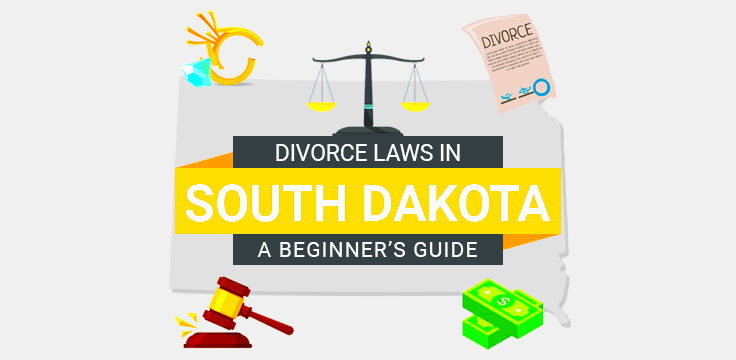Understanding South Dakota Family Law
In South Dakota, it is the family law that governs family ties, including but not limited to marriage, divorce, child custody and adoption. An understanding of these laws is critical to anyone facing family issues in this state. Family law can be complex with emotional and financial challenges. This post will capture some of the primary points related to
Key Aspects of Marriage and Divorce in South Dakota

In South Dakota, marriage constitutes a legal covenant between two people and provides definite privileges and obligations. The following are some important factors to take into account:
- Marriage Requirements: Both parties must be at least 18 years old and not closely related. A marriage license is required, which can be obtained from any county register of deeds.
- Grounds for Divorce: South Dakota recognizes both fault and no-fault grounds for divorce. No-fault divorces are typically based on irreconcilable differences, while fault divorces can include reasons like adultery or abuse.
- Divorce Process: The divorce process involves filing a petition, serving the other party, and potentially attending mediation before a final decree is issued.
Accurate understanding of these variables assists people to take right decisions at tough moments.
Child Custody and Visitation Rights in South Dakota

Custody of children is a crucial aspect of family law that entails the place where the child will stay and how parents will share the parenting obligations. In South Dakota, the court always looks for what is best for the child. The following are the primary classifications of custody:
- Legal Custody: This refers to the right to make significant decisions about the child’s upbringing, including education, health care, and religious training. Parents can share legal custody (joint) or one parent may have sole custody.
- Physical Custody: This involves where the child lives. Physical custody can also be joint or sole, affecting visitation rights for the non-custodial parent.
Thus allowing the parent not having custody to be in contact with his or her child is also of great importance in respect to visitation rights. To help their children, courts often recommend visitation schedules that may involve:
| Type of Visitation | Description |
|---|---|
| Supervised Visitation | Visits occur in the presence of a third party due to concerns about the child’s safety. |
| Unsupervised Visitation | The non-custodial parent has the child without supervision, often after a period of adjustment. |
In this way, the well-being of the child can always remain the basis for any decisions made by parents when they have clear picture of these laws.
Child Support Guidelines in South Dakota
In family law, one essential aspect is child support since it guarantees that after separation or divorce, children receive the required monetary assistance. In South Dakota, there are particular rules according to which child support can be determined. Ruling out these regulations makes the process easier for parents.
These are the core components that influence child support in South Dakota:
- Income of Both Parents: The income of both parents plays a significant role in calculating support. The state uses a formula to determine how much each parent should contribute.
- Number of Children: The more children involved, the higher the total support amount will generally be, as support is calculated per child.
- Health Insurance Costs: If one parent provides health insurance for the child, those costs can be factored into the support calculations.
Child support in Dakota’s South is usually reviewed every 2years or anytime a major change in circumstances arises. Parents may also seek modifications if they experience job loss or other financial difficulties. A short summary of the child support payment process is given below:
| Step | Description |
|---|---|
| Calculation | Use the state guidelines to calculate the support amount. |
| Order Issuance | The court issues a support order after determining the amount. |
| Payment | Payments are typically made monthly and can be set up through the state’s Child Support Division. |
Parents must really grasp the tips in order to meet their children’s requirements after divorce.
Property Division during Divorce in South Dakota
During a divorce, one of the most disputable topics is property division. Under South Dakota’s law on property division, it should be done through equitable distribution principle. This implies that even though an adjustment in marriage assets will occur through fairness, it does not have to be at 50/50 ratio.
Here are a few important things to keep in mind regarding property division in South Dakota:
- Marital vs. Non-Marital Property: Marital property includes assets acquired during the marriage, while non-marital property consists of assets owned before marriage or received as gifts or inheritances.
- Factors Influencing Division: The court considers various factors, such as the length of the marriage, each spouse’s financial situation, and contributions to the marriage, including homemaking.
- Valuation of Assets: It’s essential to accurately value all marital assets, which may include real estate, retirement accounts, and personal property.
The division process typically includes:
| Step | Description |
|---|---|
| Asset Identification | Both parties list all marital assets and debts. |
| Asset Valuation | Assets are assessed to determine their fair market value. |
| Distribution | The court divides the property based on equitable distribution principles. |
Couples need to know how property division operates so as to prepare and move easily through the tough process.
Domestic Violence and Protective Orders in South Dakota
Many families are adversely affected by domestic abuse. To ensure victims’ safety and prevent any form of further violence against them, South Dakota laws offer protection orders to be issued against such perpetrators.
When a person suffers from domestic violence, they can obtain a protective order which may consist of:
- Restraining Orders: These orders prohibit the abuser from contacting or coming near the victim.
- Temporary Custody: The order may grant temporary custody of children to the victim.
- Property Protection: It may prevent the abuser from accessing shared property or possessions.
In South Dakota, the following steps are usually followed by victims to acquire a protective order.
| Step | Description |
|---|---|
| File a Petition | The victim files a petition for a protective order at the local courthouse. |
| Court Hearing | A hearing is scheduled where both parties can present their case. |
| Order Issuance | If granted, the protective order is issued and must be served to the abuser. |
Regardless of whether they are seeking legal assistance or other support services, it is critical that victims understand what their rights are and get help. It is important to be aware of some actions that could reduce unsafe situations for people experiencing domestic violence.
Adoption Laws in South Dakota
The Adoption process is a majestic way of creating or adding more members to your family; however, it has certain rules and procedures that have to be adhered to. In South Dakota, adoption laws guarantee the child’s welfare with an eye on what is best for everyone involved. Therefore, prospective adoptive parents ought to understand these laws well.
Here’s a selection of noteworthy facts regarding adoption procedures in the state of South Dakota.
- Types of Adoption: South Dakota recognizes various types of adoption, including agency adoptions, independent adoptions, and stepparent adoptions.
- Eligibility Requirements: To adopt, individuals must be at least 18 years old and can be single, married, or divorced. Additionally, they must undergo background checks and home studies.
- Consent: Parental consent is crucial. Birth parents must voluntarily relinquish their rights, typically through a signed consent form, which can be revoked for a limited time.
In general, the way it usually goes is like this:
| Step | Description |
|---|---|
| Application | Submit an application to an adoption agency or court. |
| Home Study | A social worker evaluates the prospective adoptive home. |
| Placement | The child is placed with the adoptive family, usually for a trial period. |
| Finalization | A court hearing finalizes the adoption, granting full legal rights. |
Rabintu kuvateteuno kulo beleinyoth abuey kuon?
Analysing these statutes and methodologies would help future fathers get into adoption easier.
Frequently Asked Questions about South Dakota Family Law
Family law is often complicated and many people have questions regarding its specific aspects in South Dakota. Some of the common queries include:
- What is the process for obtaining a divorce in South Dakota? The process involves filing a divorce petition, serving your spouse, and potentially going through mediation before finalizing the divorce in court.
- How is child custody determined? Child custody is determined based on the child’s best interests, considering factors like the child’s needs, each parent’s ability to provide, and the child’s relationship with both parents.
- What are the requirements for child support? Child support amounts are determined by both parents’ incomes, the number of children, and any special needs the child may have.
- How can I get a protective order? To get a protective order, file a petition at the local courthouse, and a hearing will be scheduled where both parties can present their case.
By comprehending the responses to these inquiries, one will be able to deal with problems concerning family law more efficiently.
Conclusion on South Dakota Family Law
South Dakota family law contains a variety of significant subjects, which include marriage, divorce, child custody, child support, adoption, and protective orders. However, learning these rules is necessary as it will help to safeguard one’s rights as well as the welfare of his or her family.
One can easily make informed decisions regarding family law when they are knowledgeable enough on the subject. Knowledge is power when it comes to facing divorce, getting custody of children or adopting them. In any case, it is important to have a competent family lawyer who can help you navigate different legal processes.


